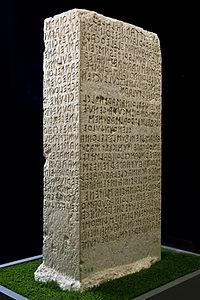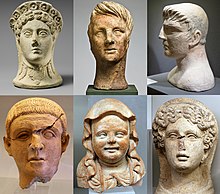Etruscan civilization
The Etruscan civilization lasted from about 900 BC to 27 BC and was a culture in ancient Italy. The Romans called the people Etrusci or Tusci. The Ancient Greeks called them Tyrrhenoi or Tyrrsenoi. The Etruscans called themselves Rasenna.
Etruscan civilization | |||||||||
|---|---|---|---|---|---|---|---|---|---|
| 900 BC–27 BC | |||||||||
 | |||||||||
| Status | City-states | ||||||||
| |||||||||




The Etruscan civilization began in pre-history. They lived in an area which included modern Tuscany, but was larger. At their height, they had three confederacies (like modern states): Etruria, Latinum and the Po Valley, and Campania. The Etruscans ruled Rome until 396 BC.
Language change
Not much is known about the Etruscan language. Not much of its writing survives. Most what survives is from engravings on tombstones. The Etruscans used an alphabet similar to those in Phoenicia and Greece.[1]
The language is related to the Tyrrhenian language family and is not clearly related to other languages. Some Etruscan letters were used by the Romans in the Latin alphabet, which many languages use. Some Romans, such as the emperor Claudius, could read and speak Etruscan.
The lack of texts makes knowledge of their society and culture depend on much later Roman sources. Politics was based on the small city and probably the family unit. In their heyday, the Etruscan elite became rich by trade with the Celtic world to the north and the Greeks to the south, and filled their large family tombs with imported luxuries. Ancient Greece had a huge influence on their art and architecture, and Greek mythology was evidently very familiar to them.
Etruscan does not survive in any great literary works, unlike Greek and Latin. An Etruscan religious literature existed, and evidence suggests that there was a body of historical literature and drama as well. For example, the name of a playwright, Volnius, is known. He wrote the "Tuscan tragedies". Although there is no evidence of notation, it is possible that Etruscan music had a written form.
History change
The Etruscans mined metals like copper and iron. They became rich and powerful and travelled around the Mediterranean Sea. The Etruscans began to lose power in the 5th century BC. The Romans began conquering parts of Etruscan land. By the beginning of the 1st century BC, the Etruscans had been entirely defeated.
Art change
Etruscan art included wall paintings, metalwork and sculpture in terracotta. Sculpture in cast bronze was famous and widely exported, but few large examples have survived because bronze was valuable and so was often recycled.[2]
Etruscan religion change
Etruscan religion was a set of stories, beliefs, and religious practices. These came from the preceding Iron Age Villanovan culture. They were heavily influenced by the mythology of ancient Greece and Phoenicia. They had similarities to Roman mythology and religion. As the Etruscan civilization was assimilated into the Roman Republic in the 4th century BC, the Etruscan religion and mythology were partially absorbed. There was a Roman tendency to absorb local gods and customs of conquered lands.
References change